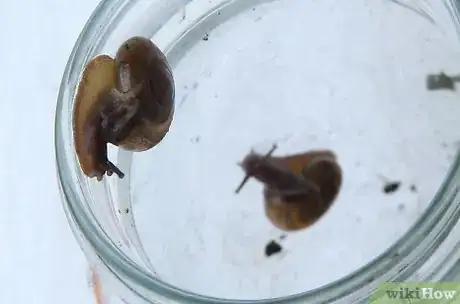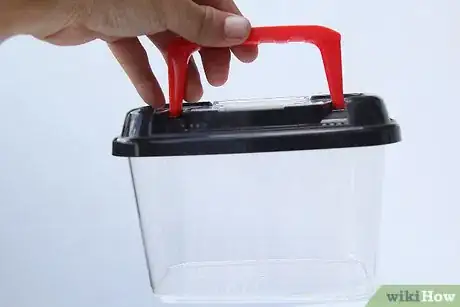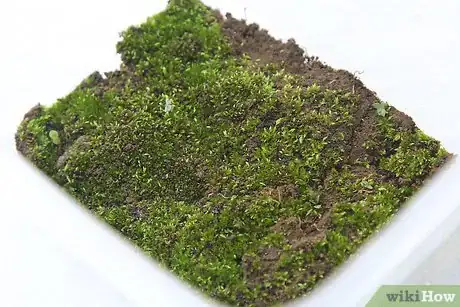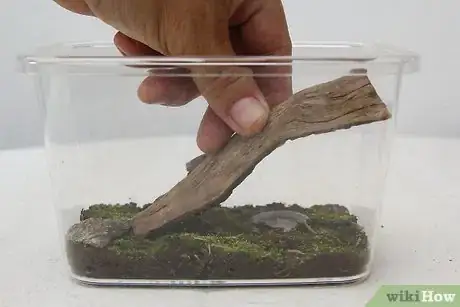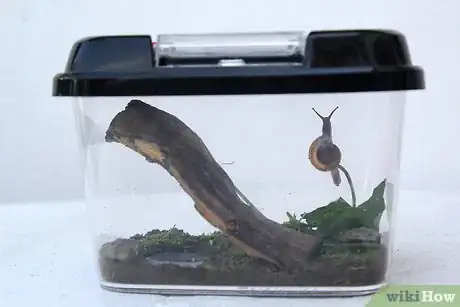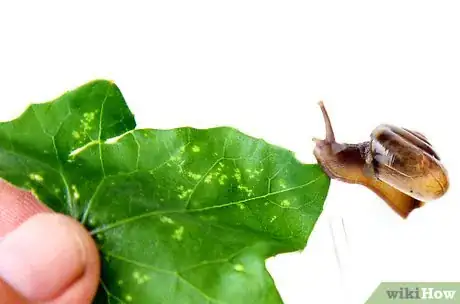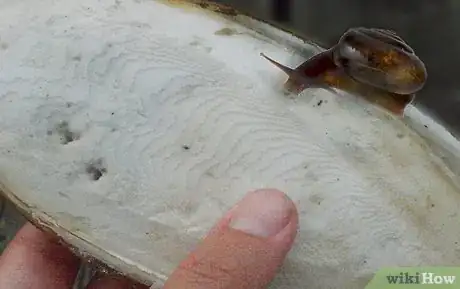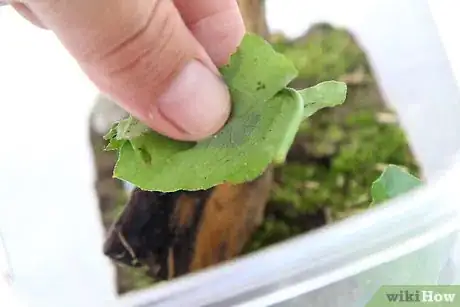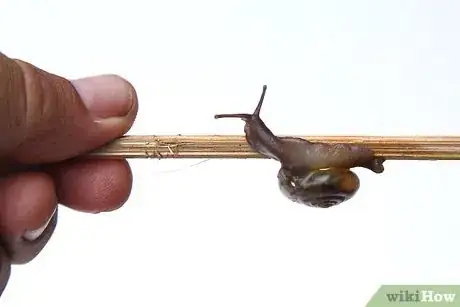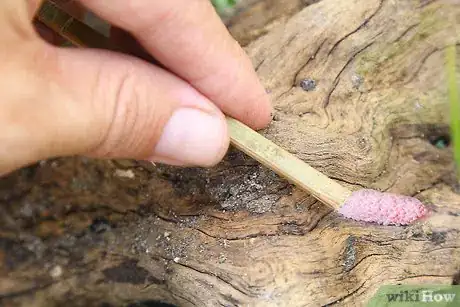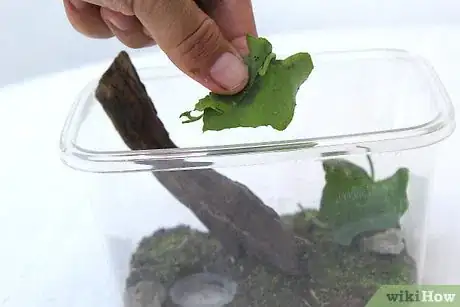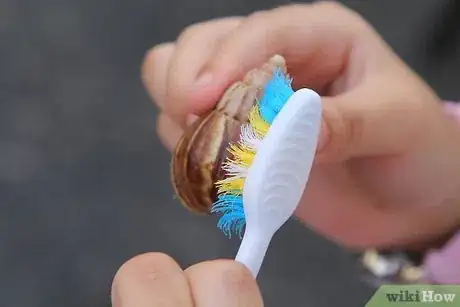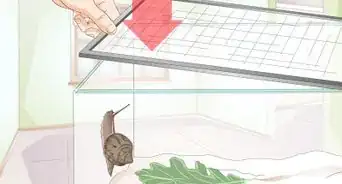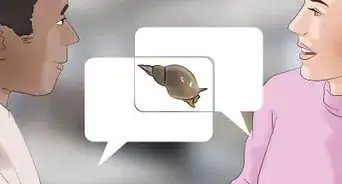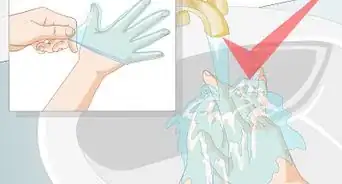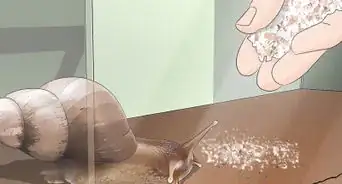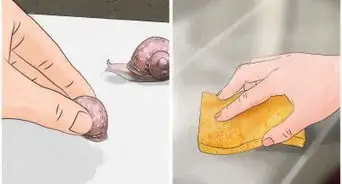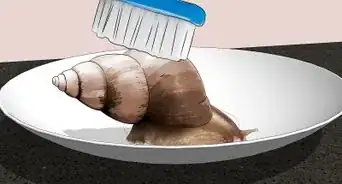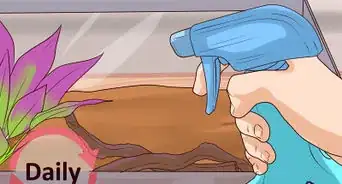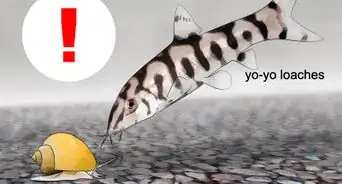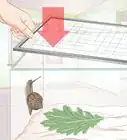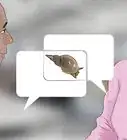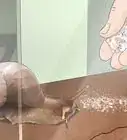wikiHow is a “wiki,” similar to Wikipedia, which means that many of our articles are co-written by multiple authors. To create this article, 68 people, some anonymous, worked to edit and improve it over time.
There are 11 references cited in this article, which can be found at the bottom of the page.
wikiHow marks an article as reader-approved once it receives enough positive feedback. This article received 56 testimonials and 91% of readers who voted found it helpful, earning it our reader-approved status.
This article has been viewed 392,690 times.
Learn more...
Snails make great first-time pets. Though slow-moving, they are fun to watch and are easier to care for than most other pets.
Steps
Choosing a Snail
-
1Decide what kind of snail you want. Snails can actually be difficult to purchase in a pet store. Garden snails can be taken straight out of your garden. Because many consider snails pests rather than pets, there are regulations on which snails can be sold where. It is illegal in the United States to import snails from other countries, and your state may even have laws against bringing in species from other states.
- Native snails can be easily found in gardens and wooded areas and are probably your best bet for your first pet snail.
- Popular snails like the Giant African Snail, Decollate snails, giant Ghana tiger snails, and margies are all illegal in the US.[1]
- Snails can live anywhere from 3-15 years in captivity. Keep in mind that this is a long-term commitment — if you don't plan on keeping a snail for that long, choose a native species so you can release your pet if you choose.[2]
- Snails like to feed on crops and gardens, and a non-native snail can do a lot of damage to local ecosystems if released.[3]
- Remember, a snail is not just a slug with a shell. If you want a pet slug, you need to research what a slug, not a snail, needs to be healthy and happy.
-
2Consider buying more than one snail. Snails enjoy companionship, and having a buddy to interact with will keep your snail entertained and happy. It will also make them more fun to observe.[4]
- The difference for caring for two snails versus one is minimal, so it will cost you very little in money or time to get your snail a companion.
- Try to stick to the same species of snail, as one species may carry different pests or diseases that are harmful to the other.[5]
- Groups of snails tend to sleep huddled together, which indicates they seek out each other's company.[6]
Making a Habitat
-
1Buy a plastic tank or container for your snail. A snail can live in a variety of enclosures — look for a translucent container with plenty of ventilation and enough space for your pet to roam and explore. Make sure the lid fits or locks tightly in place — a snail can lift 10-50 times its own weight and may lift a loose lid and escape.[7]
- If you're not sure how big your tank should be, use this calculator to find the sized based on the species and number of snails you plan to keep.
- A large "pet pal" or "critter carrier" makes a good home for land snails, as the sides are clear plastic and the lid provides great ventilation.[8]
- Glass tanks and aquariums are suitable homes for snails as well, though the heavy glass makes them more difficult to clean and transport.[9]
- A clear, translucent plastic container from a storage or craft store can work just as well as a tank. Just be certain you drill holes in the lid or top of the sides sides so your snails can breathe.[10]
- Wash your container before building the habitat inside. Use boiling water and a gentle detergent, then thoroughly rinse the container with more water. Be absolutely certain you wash out all the detergent or you may poison your snail.[11]
- Avoid wooden or cardboard containers, as they will rot. The snail may even eat through the cardboard.[12]
-
2Cover the bottom of the container with 1–2 inches (2.5–5.1 cm) of the substrate of your choice. Popular substrates include peat, coir, potting soil, and humus. Look for sterilized substrates with no pesticides or fertilizer, as this will harm your snail.[13]
- Avoid using sand, pebbles, rocks, shells, or anything brittle that the snail cannot burrow in.[14]
- Peat, coir, and potting soil are great substrates for snails to burrow. These may be found at pet or garden supply stores.[15]
- Spray the substrate in the morning and evening to keep it moist. Do not make it so wet that water is pooling in the substrate — it should be just moist enough that it sticks to your hand.[16]
- Add a little sphagnum moss to keep the substrate moist.[17]
- Be aware that soil from your yard may have pests or pesticides and could harm your snail.[18]
-
3Decorate the habitat with things your snail can crawl on and hide under. Avoid hard items like rocks, brick, or ceramic — the snail may fall from the side of the habitat and if its shell strikes a hard surface, it may crack the shell and seriously injure your pet.[19]
- Find plant pot made of plastic or polythene. Place it in the habitat on its side or cut it in half to make a cave. You could also turn the pot upside-down and cut a little opening for the snail to enter and hide inside.[20]
- Look for organic materials that won't rot quickly, like cork bark or dried tree branches. Check the reptile section at a pet store for a good selection of obstacles for your snail to play on.[21]
- A shallow water dish will give your snail a place to drink and play and also increase the moisture in the tank. Look for one with low sides and don't fill it too deep or your snail might drown. Try a resin reptile dish.[22]
-
4Pay attention to the temperature and humidity of the habitat. The temperature should be somewhere between 64–86 °F (17.8–30.0 °C), or around room temperature. Check the soil daily to make sure it hasn't dried out.[23]
- If your house gets very cold in the winter, you may want to buy a heating mat to keep the heat and humidity up in the habitat. Fix the mat to the side of the tank, covering all but 1/3 of the side. That way if the snail becomes too warm, it can move to the cooler part of the habitat.[24]
Feeding your Snail
-
1Feed your snail raw fruits and vegetables every few days. Snails enjoy a wide range of foods, like apples, mushrooms, tomatoes, bananas, strawberries, carrots, leafy greens, and much more. Try out different foods to see what your snail likes.[25]
-
2Provide a source of calcium for your snail. Calcium is essential to keeping your snail's shell healthy and strong. Cuttlefish bones are cheap and easy to find at pet shops, and will give your snails ample calcium. Keep a washed cuttlefish bone in your snail tank at all times.[29]
-
3Always clean food before feeding it to your snail. Any lingering pesticides could poison and kill your snail. Never skip this step, even with organic fruits and vegetables.[32] It is a common myth that organic produce is not treated with pesticides, but this is not always true. [33] Even if you are 100% sure that it does not have pesticides on it, do make sure you wash them as well, in case that it contains slight traces of harmful substances.
- Make sure you are washing the calcium, too.
Performing General Care
-
1Learn to handle your snail correctly. If the snail is on the side of the tank, spray your hand and the snail with water. Slip your finger under the snail's head, between the snail and the glass of the tank. Use your other hand hand to support the snail's body and gently pull as you slip your finger all the way under the snail's body. Place the snail in your palm.[34]
- Make sure your hands are wet whenever handling your snail.[35]
- If you can't get your finger under the snail's head, offer it a bit of food just out of its reach. It will stretch its head up and you can slide your finger underneath.[36]
- Wash your hands before and after handling a snail to prevent exchanging any diseases.[37]
- Don't force your snail to move. If it isn't easily detaching from the side of the tank, try to pick it up at a later time.[38]
- If you have a very small snail, try to get it to climb onto a piece of food or a leaf and transfer it into your hand. Trying to pick up a tiny snail with your hands might actually harm the snail.[39]
- Be careful not to grab the snail by the shell. If you accidentally pull off the shell, your snail will die.[40]
-
2Remove any eggs from the soil. Unless you want dozens, maybe even hundreds of baby snails, you must remove any eggs before they hatch. The eggs are round and white or translucent. You may find single eggs or clusters of hundreds of eggs. It takes about two weeks for eggs to hatch, so check the substrate for eggs every week.[41]
- Destroy the eggs by bagging them and placing them in the freezer. Make sure they are completely frozen before throwing them out.
- Do not put unwanted eggs outside, especially if you have a non-native species of snail.
- If you are worried about eggs, don't use too much substrate on the bottom of the habitat. This will make it easier to find and manage the eggs.
-
3Clean the tank once a month. Put your snail in a temporary habitat and remove everything from the tank. Wash the tank with boiling water and a little gentle detergent. Rinse the tank thoroughly — any residue from the detergent could be deadly to your snail.[42]
- Wipe down the sides of the tank with water once a week to keep it from getting too dirty between deep cleans.[43]
- Throw out any waste or rotten food you haven't already removed from the tank.[44]
- Clean the substrate or place all-new substrate on the bottom of the tank.[45]
- If you have trouble removing a snail-slime stain from the side of the container, try cleansing the stain with a little vinegar.[46]
-
4Give your snail a bath. Occasionally washing your snail with water (about once a month) can help keep it pest-free. Place your snail in a shallow dish of room-temperature water and pour or splash a little water over its body. Do not fully submerge your snail in water, or it will drown.[47]
Community Q&A
-
QuestionWould an outside snail work as a pet?
 Community AnswerAny snail would do as a pet.
Community AnswerAny snail would do as a pet. -
QuestionWhat do I not feed my pet snail?
 Community AnswerDon't feed your snail any salty foods.
Community AnswerDon't feed your snail any salty foods. -
QuestionHow do I know if my snail is a girl or boy?
 Community AnswerMost snails are hermaphrodites, which means they have both male and female sex organs.
Community AnswerMost snails are hermaphrodites, which means they have both male and female sex organs.
Warnings
- Do not squeeze the snail's shell, as this can crush it.⧼thumbs_response⧽
- Do not give the snail any sort of salt or salt solutions, as it will kill the snail.⧼thumbs_response⧽
- Do not poke the snail's soft parts. This will avoid stressing out your snail.⧼thumbs_response⧽
References
- ↑ http://animals.mom.me/caring-pet-land-snails-2666.html
- ↑ http://www.petsnails.co.uk/care/intro.html
- ↑ http://animals.mom.me/caring-pet-land-snails-2666.html
- ↑ http://www.petsnails.co.uk/care/intro.html
- ↑ http://www.petsnails.co.uk/care/substrate.html
- ↑ http://www.petsnails.co.uk/care/intro.html
- ↑ http://www.petsnails.co.uk/care/equipment.html#e_types
- ↑ http://www.petsnails.co.uk/care/equipment.html#e_types
- ↑ http://www.petsnails.co.uk/care/equipment.html#e_types
- ↑ http://www.petsnails.co.uk/care/equipment.html#e_types
- ↑ http://www.petsnails.co.uk/care/cleaning.html
- ↑ http://www.petsnails.co.uk/care/equipment.html#e_types
- ↑ http://www.petsnails.co.uk/care/substrate.html
- ↑ http://www.petsnails.co.uk/care/substrate.html
- ↑ http://www.petsnails.co.uk/care/substrate.html
- ↑ http://www.petsnails.co.uk/care/substrate.html
- ↑ http://www.petsnails.co.uk/care/substrate.html
- ↑ http://www.petsnails.co.uk/care/substrate.html
- ↑ http://www.petsnails.co.uk/care/equipment.html
- ↑ http://www.petsnails.co.uk/care/equipment.html
- ↑ http://www.petsnails.co.uk/care/equipment.html
- ↑ http://www.petsnails.co.uk/care/equipment.html
- ↑ http://www.petsnails.co.uk/care/equipment.html
- ↑ http://www.petsnails.co.uk/care/equipment.html
- ↑ http://www.petsnails.co.uk/care/feeding.html
- ↑ http://www.petsnails.co.uk/care/feeding.html
- ↑ http://www.petsnails.co.uk/care/feeding.html
- ↑ http://www.petsnails.co.uk/care/feeding.html
- ↑ http://www.petsnails.co.uk/care/feeding.html
- ↑ http://www.petsnails.co.uk/care/feeding.html
- ↑ http://www.petsnails.co.uk/care/feeding.html
- ↑ http://www.petsnails.co.uk/care/feeding.html
- ↑ https://www.ocf.berkeley.edu/~lhom/organictext.html
- ↑ http://www.petsnails.co.uk/care/handling.html
- ↑ http://www.petsnails.co.uk/care/handling.html
- ↑ http://www.petsnails.co.uk/care/handling.html
- ↑ http://www.petsnails.co.uk/care/handling.html
- ↑ http://www.petsnails.co.uk/care/handling.html
- ↑ http://www.petsnails.co.uk/care/handling.html
- ↑ http://www.petsnails.co.uk/care/handling.html
- ↑ http://animals.mom.me/caring-pet-land-snails-2666.html
- ↑ http://www.petsnails.co.uk/care/cleaning.html
- ↑ http://www.petsnails.co.uk/care/intro.html
- ↑ http://animals.mom.me/caring-pet-land-snails-2666.html
- ↑ http://www.petsnails.co.uk/care/cleaning.html
- ↑ http://www.petsnails.co.uk/care/cleaning.html
- ↑ http://www.petsnails.co.uk/care/cleaning.html
- ↑ http://www.petsnails.co.uk/care/cleaning.html
- ↑ http://www.petsnails.co.uk/care/cleaning.html
About This Article
To keep a pet snail, place it in a plastic tank or container that's lined with some potting soil. You can also put some dried tree branches and bark inside so your snail has things to climb and hide under. Spray the inside of the tank with water twice a day so it stays moist for your snail. You should also feed your snail raw fruits and vegetables every few days, like mushrooms, apples, tomatoes, and leafy greens. To learn how to handle your snail and clean its tank, keep reading!

